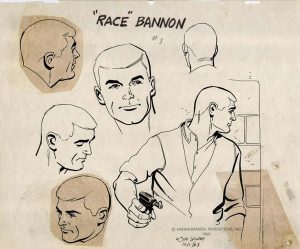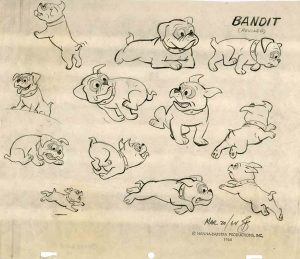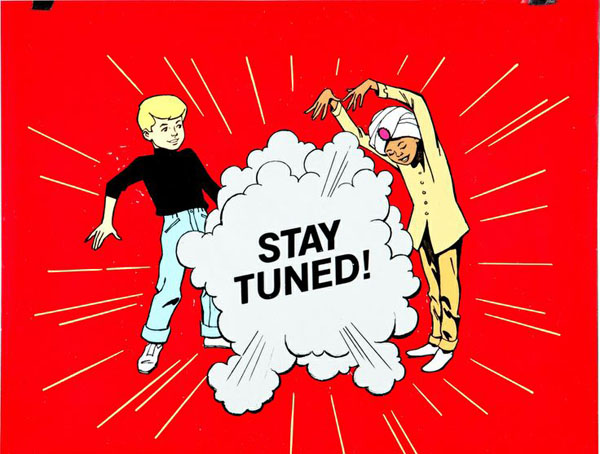
Jonny Quest is such an iconic concept that it has spawned several animated revivals, a long running comic book series as well as numerous parodies including the recent The Venture Brothers animated series on Adult Swim. Famous fans of the original 1964 animated series included author Rod Serling and filmmaker George Lucas among others.
The half hour show debuted on ABC on September 18th, 1964 and it was the first attempt on television to do animated realistic characters in a real, but exotic, world. It ran for only one season of twenty-six episodes but those episodes were so popular that they continued for many years in Saturday morning reruns on ABC, NBC and CBS.
Screen Gems, a television subsidiary of Columbia Pictures, was a partner distributing the Hanna-Barbera animated shows until 1965. Screen Gems president John Mitchell had told producers William Hanna and Joe Barbera that they “couldn’t expect to do animal stories forever. Why not try a cartoon about people?”

Back in 1986 when I was working on article about the Jonny Quest show for Amazing Heroes magazine, I got an opportunity to talk with cartoonist Doug Wildey. He told me many of the same stories, sometimes in the exact same way, as he told others over the years.
Cartoonist Doug Wildey had been working with cartoonist Alex Toth at Cambria Productions on an animated series called Space Angel that featured realistic drawings but with “Synchro-Vox” using real actors’ lips on the face drawings when the characters talked.
Friends encouraged Wildey to meet with Barbera who was looking to do a more realistic animated series. Barbera asked Wildey to do some design work on a series to be based on the vintage popular radio show Jack Armstrong but updated to the current age. The intent was to have a young teen protagonist in fast-paced adventures and mysteries.
 “So I storyboarded one, wrote some dialogue, wrote a little script and then I did a kind of presentation, showing a little continuity, a little color, and what the characters looked like,” remembered Wildey.
“So I storyboarded one, wrote some dialogue, wrote a little script and then I did a kind of presentation, showing a little continuity, a little color, and what the characters looked like,” remembered Wildey.
“I worked on that thing for, I guess, three months. The hovercraft with the natives throwing spears was done for that presentation and when there were difficulties with Hanna-Barbera getting the rights to Jack Armstrong… I guess they wanted too much money or something… we ended up using that animation in the Jonny Quest closing credits as well as some other bits.”
It was decided that an original project, rather than a licensed property, made more sense since it would be less expensive and allow greater studio control. Wildey drew on his knowledge of old movies, including Frankie Darrow and Jackie Cooper films, as well as Milt Caniff’s newspaper strip Terry and the Pirates.
Barbera loved the James Bond movie, Dr. No (1962), which is where the character of Dr. Zin as the main villain originated as well as the overall pseudo-spy tone for the show.
“I came up with the name The Saga of Chip Ballou as a working title. The characters were all the same as the final series and had the same relationships but I continued to find just the right names,” recalled Wildey.
 “I picked the name Quest out of the Los Angeles phone book because it just sounded good to me and implied adventure. It was Joe who came up with the name ‘Jonny’ without the “h” so his name is really ‘Jonathan’. I liked that. The letters just seemed right.
“I picked the name Quest out of the Los Angeles phone book because it just sounded good to me and implied adventure. It was Joe who came up with the name ‘Jonny’ without the “h” so his name is really ‘Jonathan’. I liked that. The letters just seemed right.
“The name Race Bannon came from two comic strips that I never sold. One was about an American race car driver named Stretch Bannon and the other was about a world traveling writer named Race Dunhill. So I just put the two together.
“The dog (Bandit) was not mine. I never liked the dog and still don’t. I had drawn a small white cheetah and a monkey. There are a lot of story possibilities for a monkey and it can do things realistically that a dog could never do. But they wanted a dog for some reason, maybe merchandising. It was designed by Dick Bickenbach who had done a lot of work on The Flintstones. They used (the dog) for comic relief and it was easier for some of the artists to draw funny dog stuff.”
 The episode entitled “Calcutta Adventure” was meant to introduce the character of Hadji but the production schedule was revised and when it finally aired as the seventh episode, it had to be framed as a flashback story.
The episode entitled “Calcutta Adventure” was meant to introduce the character of Hadji but the production schedule was revised and when it finally aired as the seventh episode, it had to be framed as a flashback story.
“Hadji was supposed to be a child of the streets,” said Wildey. “I wanted to use a minority character other than the typical black kid from the ghetto which so many others had used in comic strips and comic books all the time. There were objections to the character but there are always objections about everything when you are doing an animated series.
“I wanted a clear difference between these two kids who were roughly the same age, a different perspective and lifestyle to spice things up. I never wanted the magic thing to get overdone but it was in some episodes.
“I wrote the first premise of the Sargasso Sea (“Mystery of the Lizard Men”) because I wanted something mysterious but plausibly realistic. I did about two and half minutes of artwork on that thing myself to try to set the tone and the style and to show others what I wanted. I did backgrounds and figures and the timing.
 “In most cases, I do not like science-fiction. I was constantly reading magazines like Scientific American, National Geographic, Popular Mechanics, and Science Digest to get ideas and to extrapolate what might realistically exist in the next ten years because we figured the series might last that long even if just in reruns. That’s how we came up with some of those things like lasers and it ended up making the series timeless rather than tied to that particular time period.”
“In most cases, I do not like science-fiction. I was constantly reading magazines like Scientific American, National Geographic, Popular Mechanics, and Science Digest to get ideas and to extrapolate what might realistically exist in the next ten years because we figured the series might last that long even if just in reruns. That’s how we came up with some of those things like lasers and it ended up making the series timeless rather than tied to that particular time period.”
Wildey brought in respected artists like Alex Toth and Warren Tufts. Wildey’s personal favorite episode was “Shadow of the Condor” which he wrote. In the Andes, the Quests meet a World War I German ace who has a collection of vintage planes from the war and tricks Race into an air battle. One of the reasons Wildey wrote the show was because fellow artist Warren Tufts was working on the series and he was a huge airplane fanatic, even building his own planes.
In the mid-1980s, Wildey suggested to Joe Barbera to do a new version of Jonny Quest to be called Young Dr. Quest about Jonny as a twenty-two year old who has graduated from M.I.T. and sharing adventures with an older Hadji and Race Bannon. Barbera wasn’t interested perhaps because the right were still tied with Screen Gems in some way.

EDITOR’S NOTE: For more information on Jonny Quest – from the point of view of the lead character’s voice performer, Tim Matheson – check out Kevin Collier’s recent Cartoon Research mini-book, Johnny, Sinbad Jr. and Me.


 Jim Korkis is an internationally respected animation historian who in recent years has devoted his attention to the many worlds of Disney. He was a columnist for a variety of animation magazines. With his former writing partner, John Cawley, he authored several animation related books including The Encyclopedia of Cartoon Superstars, How to Create Animation, Cartoon Confidential and Get Animated’s Animation Art Buyer’s Guide. He taught animation classes at the Disney Institute in Florida as well as instructing classes on acting and animation history for Disney Feature Animation: Florida.
Jim Korkis is an internationally respected animation historian who in recent years has devoted his attention to the many worlds of Disney. He was a columnist for a variety of animation magazines. With his former writing partner, John Cawley, he authored several animation related books including The Encyclopedia of Cartoon Superstars, How to Create Animation, Cartoon Confidential and Get Animated’s Animation Art Buyer’s Guide. He taught animation classes at the Disney Institute in Florida as well as instructing classes on acting and animation history for Disney Feature Animation: Florida.




















































Ironically in 1996 Hanna Barbera and Cartoon Network decided to retool Young Dr. Quest and re titled it into The Real Adventures of Jonny Quest featuring Jonny Quest and Hadji as teenagers and newer characters were added included Jessie Bannon the biological daughter of Race Bannon and His on again off again girlfriend Jezabel Jade and Dr Quest’s father, Jonny’s grandfather to honor Jonny Quest creator Doug Widley who resides in New Mexico which was also a homage to William Hanna who was born in territorial New Mexico two years before New Mexico achieved statehood status.
Jonny Quest, Top Cat and The Jetsons all lasted a single season in prime time before going to eternal retuns on Saturday morning and then in syndication. Were the prime time ratings weak, or just insufficient to justify the costs of animation?
Rod Serling liked Jonny Quest? That’s great! Source, please?
Joe Barbera told me that and mentioned George Lucas as well in an interview I did with him in 1986 about the revival of the series.